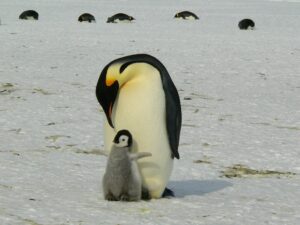In a recent study, British Antarctic Survey scientists have revealed a distressing decline in the breeding success of emperor penguins in Antarctica. The 2022 breeding season witnessed a disastrous “total breeding failure” in all but one of the five known breeding sites in Antarctica due to vanishing sea ice.
Utilizing satellite imagery, researchers observed that sea ice in the central and eastern Bellingshausen Sea area had disintegrated well before the start of the penguin chicks’ fledgling phase, during which they develop waterproof feathers, meaning there is very little chance they would have survived the disintegrating ice. This alarming research, published in the journal Communications Earth & Environment, warns that over 90% of emperor penguin colonies in Antarctica could become “quasi-extinct” by the end of the century if global warming persists at its current rate.
Peter Fretwell, the lead author and a geographic information scientist at the British Antarctic Survey, expressed his astonishment, stating, “We have never seen emperor penguins fail to breed on this scale in a single season.”
Longterm repercussions

These findings paint a bleak picture for emperor penguins and their habitats if global warming continues unchecked. Concerningly, this year’s Antarctic sea ice has plummeted to record lows, significantly below the typical extent for this time of year in the Southern Hemisphere.
Emperor penguins traditionally return year after year to the same breeding sites, laying their eggs from May to June during the Antarctic winter. After 65 days, the eggs hatch, but it’s not until December and January, the Southern Hemisphere’s summer months, that the chicks grow waterproof feathers and can leave the colonies to forage for food.
Caroline Holmes, a polar climate scientist at the British Antarctic Survey, unrelated to the penguin study but utilizing its findings to understand long-term trends, noted that in late 2022, Antarctic sea ice reached an all-time low, following a trend seen in the previous year. She explained, “We saw a very early break-up of the sea ice and an early melt, particularly in the Bellingshausen Sea region, where we have a lot of the penguin colonies.”
Satellite imagery captured in November revealed a complete absence of sea ice in the central and eastern Bellingshausen Sea regions, leading Fretwell and his colleagues to believe that it is highly probable that no penguin chicks survived in four out of the five colonies in that area.
Possible survivors?
The study highlights the possibility that some chicks might have survived on grounded icebergs, although it’s impossible to make precise estimates based solely on satellite images. If the current trajectory of global warming persists, the research indicates that more than 90% of emperor penguin colonies could become quasi-extinct by the year 2100. “Quasi-extinction” doesn’t mean the complete disappearance of all emperor penguins but signifies an inability to reproduce sufficiently to sustain the population, potentially leading to extinction, even if some individuals persist.
Fretwell emphasized, “We know that emperor penguins are highly vulnerable in a warming climate — and current scientific evidence suggests that extreme sea ice loss events like this will become more frequent and widespread.”
Holmes added that last year’s declines in Antarctic sea ice align with a broader pattern spanning nearly a decade, with the past two years recording the lowest sea ice extents in 45 years of satellite records. While various atmospheric and oceanic factors contribute to annual fluctuations in Antarctic sea ice, climate models suggest that human-induced global warming is a significant driver of long-term declines.
However, understanding the precise implications of these trends for Antarctica’s continental ice sheets and ecosystems requires more data, according to Holmes. She stressed the urgency of addressing climate change, especially considering that a certain degree of ice melt is already inevitable. “Even if we reduce emissions,” she cautioned, “there will still be some ice melt, but limiting emissions as much as possible is crucial.”
The current extent of missing sea ice, approximately 850,000 square miles less than the median value from 1981 to 2022, equates to an area larger than Greenland, as reported by the British Antarctic Survey. Holmes concluded by emphasizing that the study’s findings underscore the critical need to mitigate the impacts of climate change.


